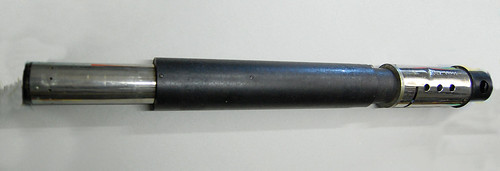Difference between revisions of "Collimation"
(a useful technique) |
Hanskerensky (talk | contribs) (Added image /29504544@N08/3426534707/ from pool) |
||
| (One intermediate revision by one other user not shown) | |||
| Line 1: | Line 1: | ||
| − | {{ | + | {{glossary}} |
| + | The verb to '''Collimate''' is derived from the Latin ''collineare'', to align.<ref name=COD>Concise Oxford Dictionary. Ninth edition, 1995, Oxford University Press, p259.</ref> It refers to the parallel alignment of light rays (making them ''collinear''), or of two or more optical instruments (such as a large telescope with the smaller one used to direct it). | ||
| + | A '''collimator''' is an instrument for producing parallel rays, for use in adjustment of other instruments.<ref name=COD/> These parallel rays may be used to simulate the rays from an object at infinite distance, and so are appropriate in adjusting the focus scale of a camera lens at infinity. | ||
| + | |||
| + | It has become a common misuse to refer to this adjustment itself as 'collimation'. It is possible to check the infinity-focus position of a lens using the [[split prism]] focus aids commonly provided in a manual-focus SLR camera. | ||
| + | {{Flickr_image | ||
| + | |image_source= http://www.flickr.com/photos/29504544@N08/3426534707/in/pool-camerawiki/ | ||
| + | |image= http://farm4.staticflickr.com/3412/3426534707_f7fc24c69a.jpg | ||
| + | |image_align= center | ||
| + | |image_text= Collimator Mont 7515 | ||
| + | |image_by= Hans Kerensky | ||
| + | |image_rights= with permission | ||
| + | }} | ||
| + | {{br}} | ||
| + | ==Notes== | ||
| + | <references/> | ||
| + | |||
| + | |||
| + | <!-- commenting out old text so I can revert this easily | ||
'''Collimation''' of a lens means adjusting it so that its infinity setting is correct. In order to collimate a lens, you need a special-purpose collimator, an infinitely distant light source, or an [[SLR]] and some ingenuity. | '''Collimation''' of a lens means adjusting it so that its infinity setting is correct. In order to collimate a lens, you need a special-purpose collimator, an infinitely distant light source, or an [[SLR]] and some ingenuity. | ||
| − | + | --> | |
==Links== | ==Links== | ||
| − | *[http://elekm.net/zeiss-ikon/repair/collimate/ Lens collimation | + | *[http://elekm.net/zeiss-ikon/repair/collimate/ Lens collimation] (with particular reference to a Contax-mount 50mm Sonnar), by [http://elekm.net/pages/ Mike Elek] |
| − | *[http://members.tripod.com/rick_oleson/index-123.html Lens collimation | + | *[http://members.tripod.com/rick_oleson/index-123.html Lens collimation], by [http://rick_oleson.tripod.com/ Rick Oleson] |
[[Category:Techniques]] | [[Category:Techniques]] | ||
Latest revision as of 06:25, 21 November 2014
The verb to Collimate is derived from the Latin collineare, to align.[1] It refers to the parallel alignment of light rays (making them collinear), or of two or more optical instruments (such as a large telescope with the smaller one used to direct it).
A collimator is an instrument for producing parallel rays, for use in adjustment of other instruments.[1] These parallel rays may be used to simulate the rays from an object at infinite distance, and so are appropriate in adjusting the focus scale of a camera lens at infinity.
It has become a common misuse to refer to this adjustment itself as 'collimation'. It is possible to check the infinity-focus position of a lens using the split prism focus aids commonly provided in a manual-focus SLR camera.

|
| Collimator Mont 7515 image by Hans Kerensky (Image rights) |
Notes
Links
- Lens collimation (with particular reference to a Contax-mount 50mm Sonnar), by Mike Elek
- Lens collimation, by Rick Oleson